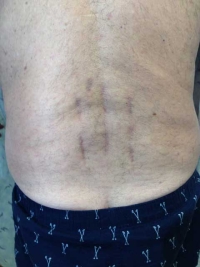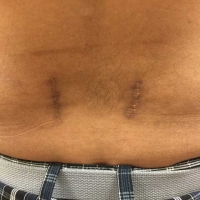Overview
There is a lumbar fusion named a “minimally invasive lumbar fusion” or “MIS”. This is not a different type of fusion but an approach “from the back side” of the spine that can be used with the PLIF or TLIF. The purpose of this type of approach is reportedly to “preserve” the muscles around the segments being fused.
There is nothing wrong with the procedure itself but the problem with this concept is that the attempted preservation of these muscles (the multifidi and transversalis) makes no sense. The multifidi and rotators are segmental muscles that insert from vertebra to vertebra. Since the two vertebrae are going to be fused together, there is no reason to preserve these muscles and actually significant reasons to move them.
In general, the greater and thicker the bony surface area for fusion, the greater the success and solidity of the fusion. Preserving these two muscles does nothing for any type of stability as these muscles cross the two vertebrae involved in the fusion and will not have any function after the fusion. Remember that the fusion is designed to stop the two vertebra’s motion. In addition, these muscles take up spots on the vertebral bone that need to be exposed to allow bone to grow. Moving them allows greater surface area for bone growth.
Are you a candidate for minimally invasive lumbar fusion?
Would you like to consult with Dr. Corenman about your condition?
You can set up a long distance consultation to discuss your
current X-rays and/or MRIs for a clinical case review.
(Please keep reading below for more information on this treatment.)
One of the claims of is that the incisions are smaller than MIMS (minimum incision microsurgery). However, if you add up the length of the necessary incisions for the “minimally invasive fusion”, they are in total longer than a MIMS procedure. Because of the location of the MIS incisions, the incisions tend to spread apart more and have less cosmetic appeal.
I have found that the fusion rate for MIS surgery tends to be less than MIMS but that might be the technique of particular surgeons and not the procedure.
Minimal Incision Microsurgery (MIMS)
Minimal Incision Microsurgery (MIMS), just like the MIS, is an approach and can be used with the TLIF or PLIF. The incision is made in the center of the spine and gives access to the fusion area and the central canal. This access allows a full decompression of any herniation or bone spur along with excellent exposure for fusion.
The incision is smaller than a surgery and has a greater success rate in my opinion.
If you live in the Vail, Aspen, Denver and Grand Junction, Colorado area and would like to learn more about
Related Content
- Surgical Repair of Pars Interarticularis Fractures Without Degenerative Disc Changes
- Scoliosis Surgery
- Transforaminal Lumbar Interbody Fusion (TLIF)
- Posterolateral Fusion (PLF)
- Anterior Lumbar Interbody Fusion
- XLIF/DLIF Far lateral Interbody Fusion
- Microdiscectomy or Fusion?
- How to Describe Your History and Symptoms of Lower Back and Leg Pain
- Best Questions to Ask When Interviewing a Spine Surgeon or Neurosurgeon
- When to Have Lower Back Surgery


